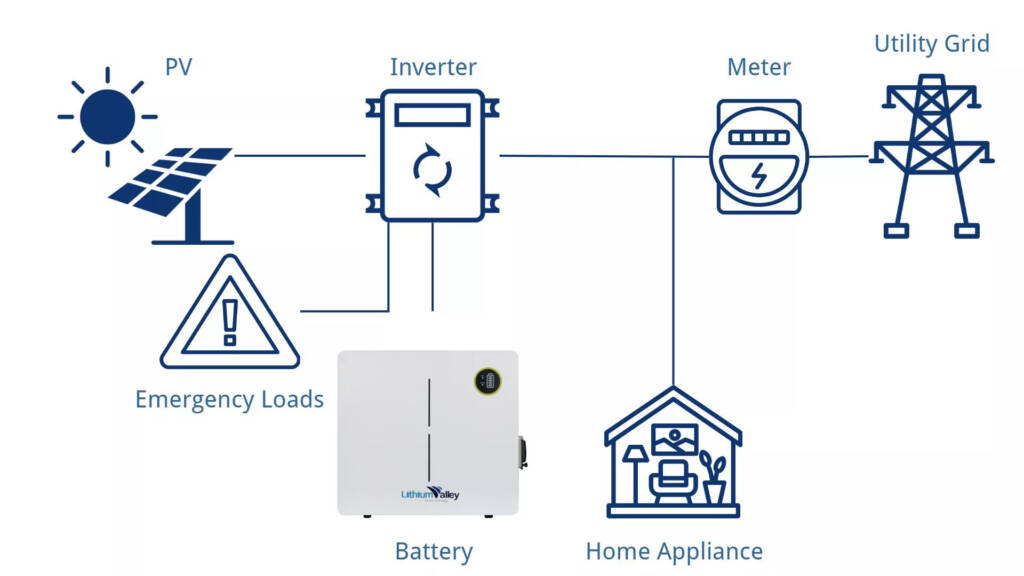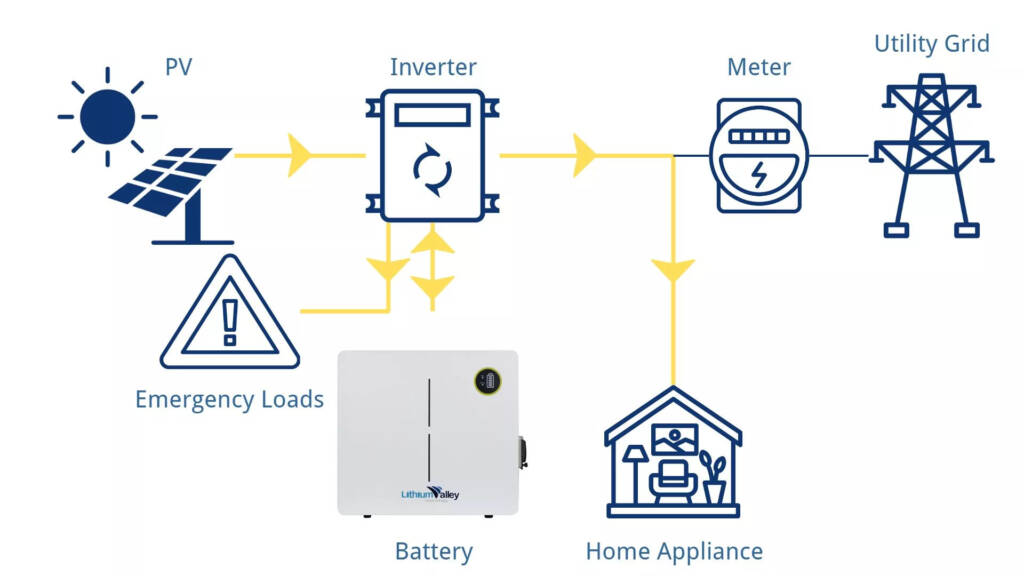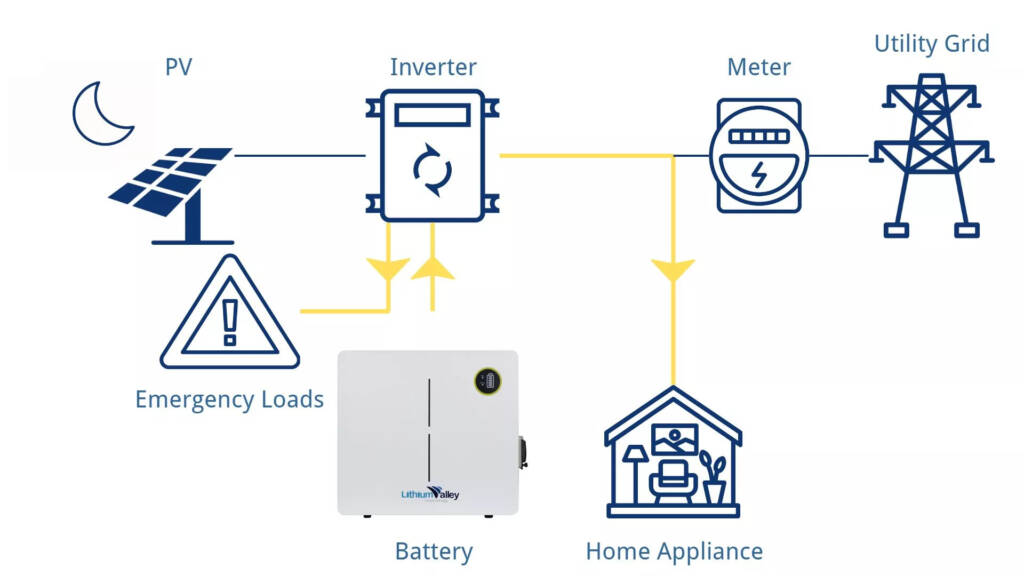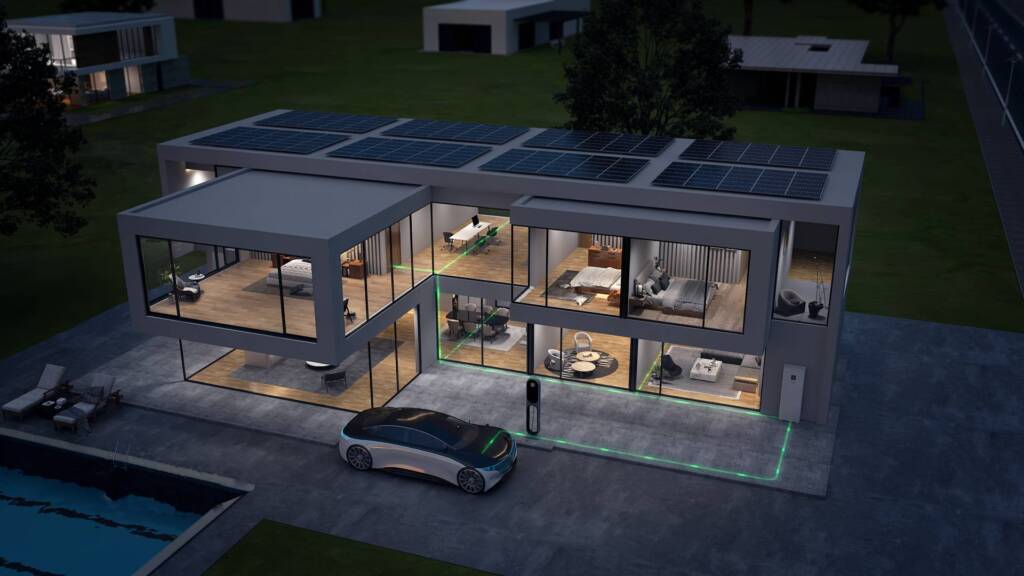To figure out why it is necessary for a PV system to be configured with a battery energy storage battery, we have to know the definition of PV ESS.
What is PV ESS?

PV ESS is the abbreviation for Photovoltaic Energy Storage System. There is instability in the conventional photovoltaic systems, while they can be upgraded to be new energy storage systems with a battery module for the immediate storage of energy. For PV systems, energy storage technology is the key to effectively solving the high and low peak power, which can realize the tracking of the load and the control of the power quality. The energy storage system can take advantage of the power price gap between peak and valley to bring higher benefits, and can also effectively adjust the capacity of the system itself to solve the problem of the combined development of renewable energy and power grids.
How does PV ESS work?
There is a big difference in the working mode of photovoltaic energy storage systems during the day and night.
Working mode in the day

The Energy Management System (EMS) works in self-consumption mode by default. Photovoltaic power will first be supplied to emergency loads and house loads, followed by batteries. Then, if the battery is fully charged, the excess will go to the grid, and the feed-in power should not exceed the limit value in the zero output setting during initial commissioning.
If the photovoltaic power is less than the load power, the battery will discharge and provide insufficient energy. If the power from PV and battery is less than the load power, the inverter will draw power from the mains.
Working mode in the night

The battery discharges to provide energy to the load. If the battery is dead or the battery system does not have enough power, the unsatisfied power will first be provided by the grid to emergency loads and household loads.
When the grid exists, the bypass function of the hybrid inverter works, and the emergency load will be directly connected to the grid through the bypass relay integrated into the inverter. Emergency loads are powered by photovoltaic or battery energy first and are supplemented by the grid when photovoltaic and battery energy is insufficient.
Why choose a PV Storage System?
There are many benefits to PV ESS, although the cost of installing PV ESS cannot be ignored. Below we have listed some suggestions that may be helpful to you. According to our suggestions, you may be able to know whether it is necessary for you to choose PV systems with battery energy storage systems.
1. High Power Generation Efficiency and Low Cost
The photovoltaic equipment of PV ESS can absorb solar energy and convert it into electrical energy during the day, and the energy storage equipment will store this electrical energy, and then convert the stored electrical energy into AC power required by the grid and release it at night. To a certain extent, this realizes the self-use of photovoltaic power generation, which not only improves the efficiency of power generation but also converts solar energy into electric energy, which greatly reduces the cost of power generation and electricity consumption. With the outbreak of the worldwide energy crisis and the rise in energy prices, PV ESS can largely avoid such adverse effects.
2. Provide Clean Energy to Help Save Energy and Reduce Emission
The electrical energy provided by this system is converted from renewable and cleaner solar energy. As a result, this has played a role in saving energy to a large extent. In addition, the electricity generated by this power generation system has fewer harmonics and is purer electric energy. It can not only achieve energy saving and emission reduction but also improve the quality of the power grid.
3. Tax Incentives
The federal Investment Tax Credit (ITC), allows any U.S. resident to deduct 26% of the cost of installing solar panels on their home from their federal tax bill. Many people don't realize it, but the same tax credit also applies to solar battery storage.
The "Inflation Reduction Act" passed in August this year has significantly improved the economics of deploying large-scale battery energy storage projects in the United States. Standalone energy storage systems will be eligible for a 30% investment tax credit (ITC) and a tax credit-free discount of up to 70%.
In addition to federal tax credits, every U.S. state offers some type of rebate or incentive to purchase photovoltaic panels and batteries.In Europe and other regions, various governments have also introduced corresponding tax incentives for photovoltaics.
4. Resilience During Outages
For areas with frequent natural disasters, power is often easily interrupted, affecting normal life order. Usually, gas generators can handle this situation, but generators are noisy, expensive, expensive to maintain, and harmful to the environment, making them not an ideal option. However, for areas with PV ESS installed, during the outages, the backup battery can still ensure the normal operation of necessary electrical appliances and avoid the inconvenience caused by power outages to life.
- 3C batteries (1)
- 48C Advanced Energy Project Credits (1)
- ActiveBalancing (1)
- Advanced Storage Solutions (1)
- advanced technologies (1)
- African market (1)
- AI Algorithms (1)
- AI in Energy Storage (1)
- air conditioning (1)
- All-in-One Energy Storage (1)
- American electricity market (1)
- ancillary services market (1)
- application scenarios (2)
- Arnstadt (1)
- automotive industry (1)
- backup generators (1)
- Backup power (1)
- batteries (2)
- Battery Discharge (1)
- Battery Energy Storage (1)
- Battery Energy Storage Systems (1)
- Battery Energy Storage Systems (BESS) (1)
- battery factory (1)
- battery industry event (1)
- battery management system (3)
- battery management systems (1)
- battery market (1)
- battery materials (1)
- battery pack (1)
- Battery Storage Safety (1)
- Battery technologies (1)
- battery technology advancements (1)
- battery type (1)
- BatteryLongevity (1)
- BatteryManagementSystem (1)
- BatterySafety (1)
- BatteryTechnology (1)
- BESS (1)
- Birmingham Exhibition (1)
- BMSArchitecture (1)
- Brazil energy storage (1)
- Burkina Faso (1)
- Capacity (1)
- capacity rule (1)
- carbon management (1)
- carbon neutrality goals (1)
- CATL (1)
- CE marking (1)
- certification (1)
- certifications (1)
- Charge Current (1)
- Charge/Discharge Rate (1)
- Chemical Storage (1)
- China electricity market (1)
- China International Battery Fair (1)
- CIBF 2023 (1)
- Clean energy (6)
- clean energy incentives (1)
- Clean Energy Revolution (1)
- clean energy solutions (1)
- Climate Goals (1)
- Climate Legislation (1)
- Commercial (1)
- Commercial Energy Storage (2)
- CompleteCurrentControl (1)
- Compressed Air Energy Storage (CAES) (1)
- consumer batteries (1)
- Containerized Energy Storage (1)
- Continuous Discharge Duration (1)
- conversion efficiency (1)
- Cooperation (1)
- cost composition (1)
- cost parity (1)
- cost reduction (1)
- Cost-effective storage (1)
- critical power (2)
- CSA certification (1)
- Customized Energy Storage (1)
- DC bus voltage (1)
- Decarbonization (1)
- Decarbonized future (1)
- Demand Forecasting (1)
- Department of Energy (1)
- DesignConsiderations (1)
- development strategies (1)
- Direct Pay (1)
- Discharge Current (1)
- discharge curve (1)
- Distributed Energy (1)
- Dongguan Lithium Valley (2)
- dual carbon goal (1)
- Dubai World Trade Center (1)
- efficient energy storage (1)
- Electric Vehicle Charging (1)
- Electric Vehicles (2)
- Electricity Costs (1)
- Electricity Infrastructure Operations Center (1)
- electricity market (1)
- electricity price mechanism (1)
- electricity prices (1)
- electricity supply (1)
- electrochemical energy storage (1)
- Electrochemical Storage (1)
- Energy Certification (1)
- Energy Community Adder (2)
- energy companies (1)
- energy consumption (1)
- energy consumption management (1)
- energy crisis (1)
- Energy Demand (1)
- Energy Demands (1)
- energy density (2)
- energy distribution (1)
- Energy Efficiency (1)
- energy industry (1)
- Energy Industry Solutions (1)
- energy investment (1)
- Energy Landscape (1)
- Energy Management System (3)
- energy management systems (1)
- energy professionals (1)
- energy sector (1)
- energy solutions (2)
- Energy storage (16)
- Energy Storage Batteries (3)
- Energy storage battery business (1)
- Energy Storage Battery Industry (1)
- Energy Storage Battery Technology (1)
- energy storage business model (1)
- Energy Storage Cabinets (1)
- energy storage capacity (1)
- Energy Storage Certification (1)
- Energy Storage Challenges (1)
- energy storage components (1)
- energy storage converters (1)
- energy storage equipment (1)
- Energy Storage Incident (1)
- energy storage industry (4)
- energy storage market (1)
- Energy Storage Products (1)
- energy storage profitability (1)
- energy storage projects (1)
- Energy storage research (1)
- Energy Storage Solution (2)
- Energy Storage Solutions (4)
- Energy Storage System (3)
- energy storage system solutions (1)
- Energy Storage Systems (5)
- Energy Storage Technologies (2)
- Energy Supplies (1)
- Energy Supply Challenges (1)
- Energy Transition (1)
- energy trends (1)
- EnergyEfficiency (1)
- EnergyStorage (1)
- Environmental Innovation (1)
- environmental sustainability (1)
- ESS chain (1)
- EU countries (1)
- European battery factory (1)
- European electricity market (1)
- European Market (1)
- European Solar Market (1)
- Exhibitors (1)
- Extended Tax Credits (1)
- field study (1)
- financing options (1)
- fire protection systems (1)
- Flexibility (2)
- Flow batteries (2)
- Flywheel Energy Storage (1)
- Fossil Fuel Emissions (1)
- fossil fuels (1)
- generation side (1)
- Germany (2)
- Gigawatts (1)
- Global Carbon Emissions (1)
- global energy storage (1)
- global market share (1)
- global power batteries (1)
- government officials (1)
- Government Support (1)
- granular silicon (1)
- Green Energy Initiatives (1)
- Green Living (1)
- Green Technology (2)
- Greenhouse Gas Emission Verification (1)
- grid (1)
- Grid reliability (2)
- grid resilience (1)
- grid side (1)
- Grid Stability (3)
- Grid Storage Launchpad (1)
- grid voltage (1)
- grid-connected (1)
- Guide (1)
- high-voltage battery (1)
- higher discharge rate (1)
- Home Energy Storage (3)
- Home Energy Storage Benefits (1)
- household energy storage (2)
- hydropower (1)
- I&C energy storage (1)
- IEC 62619 (2)
- IEEE 1547 (1)
- inductive loads (1)
- Industrial (1)
- industrial and commercial energy storage (1)
- industrial and commercial track (1)
- Industrial Energy Storage (6)
- Industry Trends (1)
- IndustryStandards (1)
- Inflation Reduction Act (1)
- Inflation Reduction Act (IRA) (1)
- installed energy storage (1)
- integrated energy storage cabinet (1)
- integration (1)
- intelligent solutions (1)
- Intermittency (1)
- International Energy Agency (1)
- International Energy Agency (IEA) (1)
- International Energy Storage Exhibition (1)
- Intersolar (1)
- Intersolar Europe 2023 (1)
- Intersolar Middle East (1)
- Intertek (1)
- inverter (2)
- inverter power (1)
- Investment (1)
- Investment Tax Credits (1)
- ISO 14001 (1)
- ISO 9001 (1)
- ITC (1)
- Johannesburg (1)
- large size silicon (1)
- large-scale energy storage (1)
- Leveraging Solar Power (1)
- life cycles (1)
- LiFePO4 batteries (1)
- lithium batteries (1)
- lithium iron phosphate batteries (2)
- Lithium Prices (1)
- Lithium Valley (14)
- Lithium Valley Products (1)
- Lithium Valley Technology (1)
- Lithium-ion alternatives (1)
- Lithium-Ion Batteries (3)
- lithium-ion battery cells (1)
- lithium-ion voltage (1)
- load capacity (1)
- Long Beach California (1)
- Long Duration Energy Storage (1)
- Long-duration storage (2)
- Low-carbon Future (1)
- low-voltage battery (1)
- LS Energy Solutions (1)
- M&A project (1)
- manufacturing equipment (1)
- Market Opportunities (1)
- market-oriented (1)
- Mechanical Storage (1)
- MEE (1)
- merger agreement (1)
- Microgrids and Distributed Energy (1)
- Middle East Energy Summit (1)
- Mobile Energy Storage (1)
- Multiple-MPPT (1)
- Na+ battery (1)
- Net Zero Emissions (2)
- Netherlands (1)
- new energy battery technology (1)
- Next-generation batteries (1)
- North America (1)
- NREL (1)
- off-grid (1)
- oil and gas (1)
- operating efficiency (1)
- optical storage (1)
- Pacific Northwest National Laboratory (1)
- PassiveBalancing (1)
- Peak Times (1)
- peak-valley price difference (1)
- Photovoltaic (PV) Solar Power (1)
- photovoltaic components (1)
- photovoltaic installations (1)
- plug-and-play (1)
- policy certainty (1)
- polysilicon (1)
- power batteries (1)
- power battery company (1)
- power battery developments (1)
- power conversion system (1)
- power density (1)
- Power Generation (2)
- power match (1)
- power supply (1)
- power system (1)
- power systems (1)
- power transmission (1)
- Power/Energy (1)
- Predictive Analytics (1)
- Product Carbon Footprint Certificate (1)
- product line (1)
- product upgrades (1)
- production capacity (2)
- production process (1)
- profit model (1)
- Pumped Hydro Storage (1)
- quality management system (1)
- R&D team (1)
- raw materials (1)
- regional energy transformation (1)
- Reliability testing (1)
- Reliable Power Supply (1)
- renewable energy (18)
- renewable energy capacity (1)
- Renewable Energy Industry (1)
- Renewable energy integration (2)
- renewable energy investment (1)
- renewable energy policies (1)
- renewable energy production (1)
- Renewable Energy Revolution (1)
- Renewable Energy Solutions (1)
- renewable energy sources (1)
- Renewable Energy Storage (1)
- RenewableEnergy (1)
- renewables sector (1)
- Residential & Commercial Energy Storage (1)
- residential energy storage (2)
- rural energy storage (1)
- safer energy storage (1)
- Sandton Convention Centre (1)
- Scalability (1)
- service life (1)
- shadow scan function (1)
- signing ceremony (1)
- silicon materials (1)
- silicon wafers (1)
- single-cluster battery management (1)
- Single-MPPT (1)
- smarter energy storage (1)
- SNEC Exhibition (1)
- Sodium-ion batteries (1)
- Sodium-ion Battery (1)
- Solar & Storage Live 2023 (1)
- Solar Capacity (1)
- solar cells (1)
- Solar Energy (2)
- Solar Energy Industry (2)
- solar energy products (1)
- solar energy storage (1)
- Solar Energy Technologies (1)
- Solar Generation (1)
- Solar Installations (1)
- solar integration (1)
- solar modules (1)
- solar panel energy storage (1)
- solar power (2)
- Solar PV (1)
- Solar Show Africa 2023 (1)
- Solar Sustainability (1)
- solar trends (1)
- Solar-Plus-Storage Integration (1)
- Solid-State Batteries (1)
- South African Minister of Energy (1)
- Stacked High-Voltage Battery (1)
- standardization (1)
- StateEstimation (1)
- Storage Installations (1)
- Storage Ratio (1)
- Storage Systems (1)
- Strategy Director (1)
- SUMEC (1)
- Supplier Conference (1)
- supply chain cost (1)
- Supply Chain Traceability (1)
- surge power (1)
- Surplus Energy (1)
- Sustainability (1)
- Sustainable Development (1)
- Sustainable Energy (2)
- Sustainable Future (1)
- Sustainable Power Grid (1)
- sustainable power solutions (1)
- Sustainable Practices (1)
- Sustainable Technology (1)
- SustainableEnergy (1)
- system structure (1)
- TD (1)
- technical components (1)
- Technological Innovation (2)
- technology exchange (1)
- Temporary Power Solutions (1)
- ternary lithium batteries (1)
- Thermal Storage (1)
- Thuringia (1)
- Transferability (1)
- transparent reporting (1)
- TUV certification (1)
- Types of Energy Storage Systems (1)
- UK (1)
- UK Legislation (1)
- UL 1973 (2)
- UL 9540A (1)
- US Federal Government (1)
- US manufacturers (1)
- US public investments (1)
- user side (1)
- Utilities (1)
- voltage match (1)
- wholesale market (1)
- Wind Capacity (1)
- Wind Energy (1)
- Wind Generation (1)
- Wind Installations (1)
- wind power (1)
- winter energy demand (1)
- Zero Emissions (1)
- Zonsen Power (1)
- ZZonsen Power (1)

